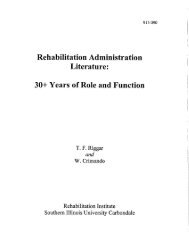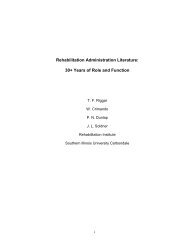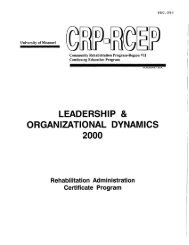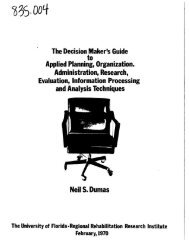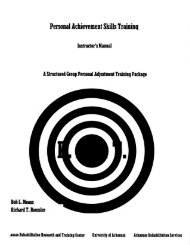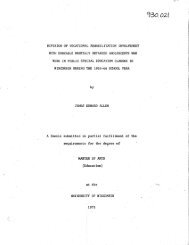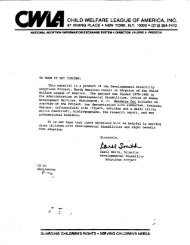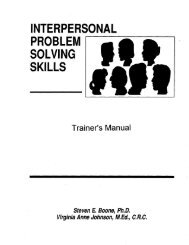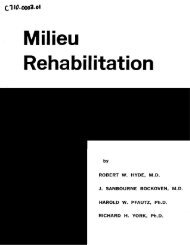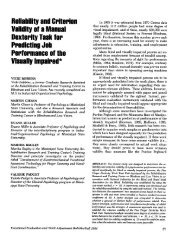Meeting Global Deaf Peers, Visiting Ideal Deaf Places ... - NCRTM
Meeting Global Deaf Peers, Visiting Ideal Deaf Places ... - NCRTM
Meeting Global Deaf Peers, Visiting Ideal Deaf Places ... - NCRTM
Create successful ePaper yourself
Turn your PDF publications into a flip-book with our unique Google optimized e-Paper software.
DEAF WAYS OF EDUCATION LEADING TO EMPOWERMENT<br />
of change such as <strong>Deaf</strong> President Now.<br />
Widell (2000) explored the emergence<br />
of deaf empowerment in Denmark by<br />
examining “the dynamics between the<br />
education system, the labor market,<br />
and deaf culture” (p. 26). For my research<br />
project, I examined deaf empowerment<br />
in Flanders, the northern<br />
half of Belgium, through the collection<br />
of life stories of Flemish deaf leaders.<br />
This case study is being linked with an<br />
exploratory case study (Stebbins, 2001;<br />
Yin, 1994) at Gallaudet University of<br />
deaf empowerment as exemplified<br />
in the lives of international deaf role<br />
models.<br />
Research on deaf life stories reveals<br />
turning points in deaf people’s lives<br />
when they learned about deaf cultural<br />
rhetoric—mostly highlighting transformations<br />
when these people moved<br />
from an oral environment to a signing<br />
and deaf cultural environment.<br />
Amparo Minguet Soto (2003), for<br />
example, uses the metaphor of “<strong>Deaf</strong><br />
awakening” in her life story to give<br />
meaning to the turning point in her<br />
life after coming into contact with sign<br />
language, deaf culture, and (international)<br />
deaf leaders. She connects this<br />
experience with the metaphorical<br />
transition from darkness to light that<br />
is often used to describe deaf people’s<br />
entering the deaf community and<br />
learning sign language (Padden &<br />
Humphries, 1988). Soto does not reveal<br />
whether this experience is expressed<br />
by a sign that refers to a<br />
shared deaf experience in her community,<br />
like the WAKE-UP sign in my<br />
research (see below, “Waking Up and<br />
the Circle of <strong>Deaf</strong> Empowerment”).<br />
Although changes in deaf people<br />
who grew up in a deaf cultural environment<br />
have been sporadically examined<br />
(Breivik, 2005; Ladd, 2003;<br />
List, 2003; Taylor & Darby, 2003), the<br />
phenomenon of deaf empowerment<br />
and its rhetoric have never been examined<br />
through ethnographic life-<br />
6<br />
story research in a group of people<br />
who have assumed leadership roles in<br />
a local deaf community. Also, though<br />
“there is no guarantee that a particular<br />
discourse or form of knowledge<br />
will lead to emancipatory practices”<br />
(Foucault, 1984, cited in Roets et al.,<br />
2005, p. 47), narrative research with<br />
survivors can indicate keys to the success<br />
of life paths (Roets et al., 2005).<br />
The analysis of Flemish deaf narratives<br />
in the present article leads to the<br />
hypothesis that visits to barrier-free<br />
deaf environments (Jankowski, 1997)<br />
such as Gallaudet University (United<br />
States), the Centre for <strong>Deaf</strong> Studies in<br />
Bristol (United Kingdom), and deaf<br />
associations in the Nordic countries<br />
are transformative for deaf people.<br />
The universal nature of sign language<br />
(Mottez, 1993) and the common<br />
transnational experiences of deaf people<br />
as a “visual minority in an auditory<br />
world” (Murray, in press) create the<br />
conditions for an alternative deaf education<br />
or education in the deaf way.<br />
Only 20% of all deaf people in the<br />
world have the opportunity to go to<br />
school (Wilson, 2005), and consequently<br />
to gain deaf awareness and<br />
knowledge about sign language. In<br />
the world, and especially in developing<br />
countries, there is a “lack of respect<br />
for and understanding of <strong>Deaf</strong><br />
Culture and sign language (Lane, 1992;<br />
Lemmo, 2003)” (Wilson, 2005, p. 293).<br />
The goal of the present article is to<br />
sketch alternative opportunities for<br />
deaf students all over the world to<br />
come into contact with deaf cultural<br />
rhetoric and experience barrier-free<br />
deaf environments (Jankowski, 1997)<br />
and to create the conditions to<br />
achieve their civil, political, social, and<br />
economic rights (Harris & Enfield,<br />
2003; Ladd, 2003).<br />
Since 1993, Belgium has been a<br />
federalized monarchy comprising two<br />
states: Flanders in the north and Wallonia<br />
in the south. The official spoken<br />
languages of Flanders and Wallonia<br />
are, respectively, Dutch (Flemish) and<br />
French. The differences between<br />
Flemish and Dutch can be compared<br />
to the differences between British and<br />
American English. In eastern Belgium<br />
there is also a small German-speaking<br />
jurisdiction (Van Herreweghe, 2002).<br />
A first (unrepresentative) demographic<br />
research study suggests that<br />
about 4,500 deaf signers use Flemish<br />
Sign Language, Vlaamse Gebarentaal<br />
(VGT; Loots et al., 2003). Only recently,<br />
on April 26, 2006, the Flemish parliament<br />
recognized VGT as the “first or<br />
preferred language of the <strong>Deaf</strong> community<br />
in Flanders” (Heyerick, 2006).<br />
<strong>Deaf</strong> people in the southern part of<br />
Belgium use Belgian-French Sign Language<br />
(Langue des Signes de Belgique<br />
Francophone, LSFB), which was officially<br />
recognized in 2003 (Timmermans,<br />
2005). Although the spoken<br />
languages in Flanders and the Netherlands,<br />
on the one hand, and in Wallonia<br />
and France, on the other, are<br />
similar, VGT differs from NGT (Nederlandse<br />
Gebarentaal, Sign Language<br />
of the Netherlands), and LSFB is different<br />
from LSF (Langue des Signes<br />
Françaises, French Sign Language).<br />
Since the national deaf federation<br />
Navekados divided in the 1970s, the<br />
Flemish deaf community has been<br />
represented by Fevlado (Federatie<br />
van Vlaamse Dovenorganisaties—<br />
Federation of Flemish <strong>Deaf</strong> Organizations);<br />
the Walloon deaf community<br />
has its own national federation, FSSB<br />
(Fédération Francophone des Sourds<br />
de Belgique—French Federation of<br />
Belgian <strong>Deaf</strong>). Because the Flemish<br />
and Walloon deaf federations are<br />
funded by their own sources and have<br />
their own agendas, Flemish and Walloon<br />
deaf people meet and interact<br />
less than before the split of the national<br />
deaf federation, and Flemish<br />
Sign Language and Walloon Sign Language<br />
continue to “develop separately<br />
VOLUME 152, NO. 1, 2007 AMERICAN ANNALS OF THE DEAF




